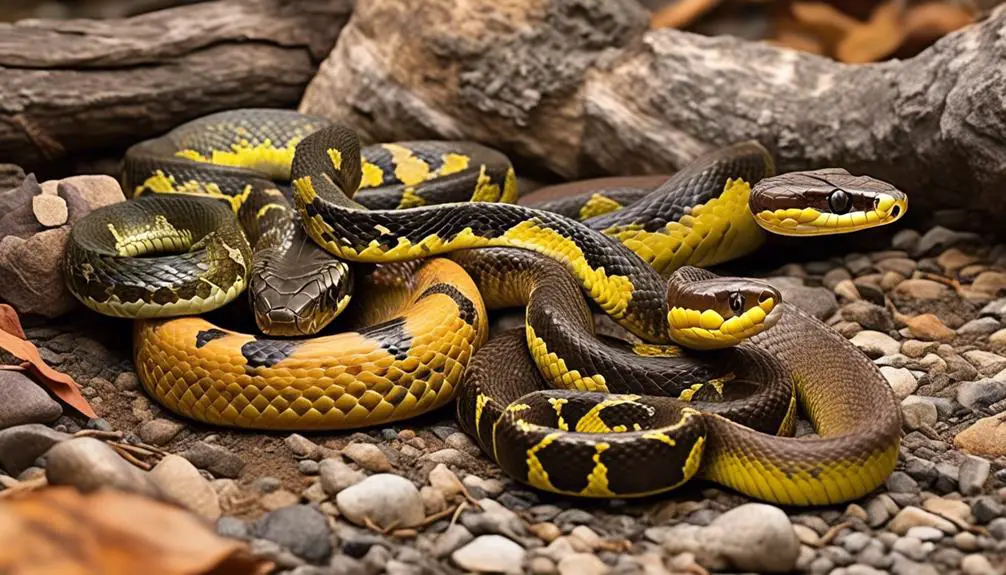Did you know that Canada is home to over 50 species of snakes, both venomous and non-venomous?
These slithering creatures have adapted to various habitats across the country, from grasslands to wetlands and forests.
While some snakes may pose a threat to humans with their venomous bites, others are harmless and play important roles in maintaining the balance of ecosystems.
In this discussion, we will explore the intriguing world of non-venomous and venomous snakes in Canada, uncovering their unique characteristics and shedding light on the importance of coexisting with these often misunderstood creatures.
So, buckle up and prepare to discover the remarkable diversity of snakes found in the Great White North.
Venomous Snakes in Canada
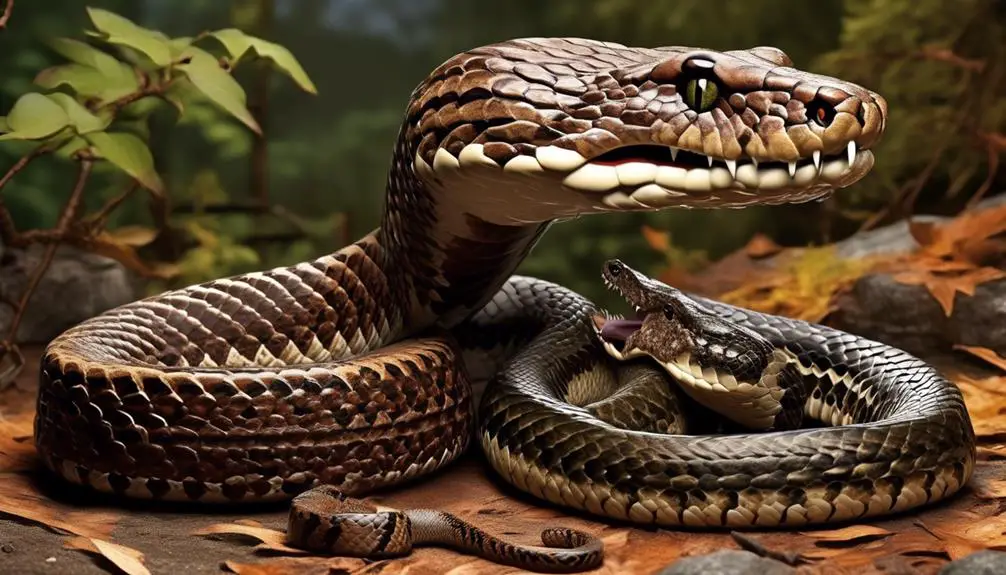
Canada is home to several venomous snake species, including the Western rattlesnake, the Prairie rattlesnake, and the Massasauga.
The Western rattlesnake, scientifically known as Crotalus oreganus, can be found in select parts of the British Columbian mountains. Belonging to the pit-viper branch of snakes, it can grow up to 1.5 meters in length. Its distinctive bronze, brown, and tan patterning is a notable characteristic. Highly venomous, a bite from the Western rattlesnake can lead to symptoms such as nausea and respiratory paralysis.
Another venomous snake species found in Canada is the Prairie rattlesnake, also known as Crotalus viridis. It inhabits areas in Alberta and Saskatchewan. Typically measuring about a meter in length, Prairie rattlesnakes exhibit color schemes that vary, often displaying light browns, beiges, and off greys. Their viper-like head shape is recognizable, and they warn of an impending attack with a rattling sound, delivering a potent bite.
The Massasauga, scientifically known as Sistrurus catenatus, can be found in a small corner of southern Ontario. Usually not exceeding 70cm in length, Massasaugas have dark coloring heavily patterned with diamond-like camouflage. They’re versatile survivalists, capable of living in various habitats. Like the Western and Prairie rattlesnakes, they’re highly venomous, with bites being fatal if left untreated.
In Canada, these venomous snakes pose a significant threat to humans, and caution should be exercised when encountering them in the wild. Understanding their characteristics and habitat can help reduce the risk of encounters and ensure the safety of both humans and these important components of Canada’s biodiversity.
Western Rattlesnake (Crotalus oreganus)
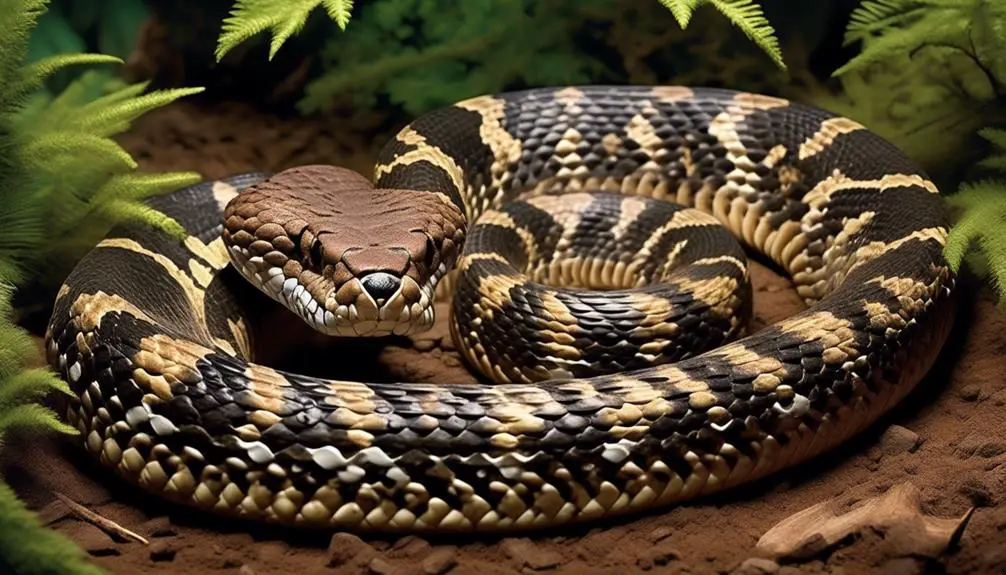
The Western rattlesnake, scientifically known as Crotalus oreganus, is a venomous snake species found in select parts of the British Columbian mountains. This species belongs to the pit-viper branch of snakes and can grow up to 1.5 meters in length. Its distinctive bronze, brown, and tan patterning makes it easily recognizable. The Western rattlesnake is highly venomous, with symptoms including nausea and respiratory paralysis. To provide a quick overview of the differences between venomous snakes in Canada, refer to the table below:
| Snake Species | Length | Coloration | Venomous |
|---|---|---|---|
| Western rattlesnake (Crotalus oreganus) | Up to 1.5 meters | Bronze, brown, and tan | Yes |
| Prairie rattlesnake (Crotalus viridis) | About a meter | Light browns, beiges, and off greys | Yes |
| Massasauga (Sistrurus catenatus) | Up to 70cm | Dark with diamond-like camo | Yes |
It is important to be aware of these venomous snakes in order to avoid potential encounters and to take appropriate precautions when exploring their habitats.
Prairie Rattlesnake (Crotalus viridis)
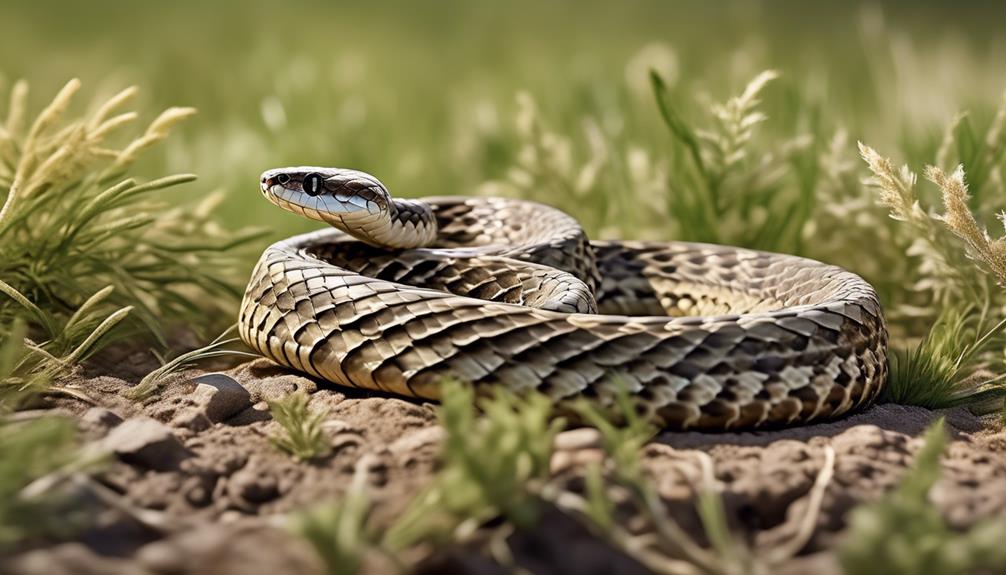
The Prairie Rattlesnake, scientifically known as Crotalus viridis, is a venomous snake found in Alberta and Saskatchewan in Canada. Typically measuring around a meter in length, this species exhibits varying color schemes, often consisting of light browns, beiges, and off greys.
With its recognizable viper-like head shape and the ability to warn of an impending attack with its rattling sound, the Prairie Rattlesnake delivers a potent bite, making it an important snake to study and understand in order to ensure human safety in its habitat.
Size and Appearance
With lengths typically reaching about a meter, the Prairie Rattlesnake (Crotalus viridis) showcases a distinctive viper-like head shape and a range of color schemes consisting of light browns, beiges, and off greys.
This venomous snake has a robust body and a tail that ends in a rattling appendage. The head is triangular in shape, allowing for the accommodation of venom glands. It has a pair of heat-sensing pits located between the nostrils and the eyes, which enables it to detect warm-blooded prey.
The scales on its body are keeled, giving it a rough texture. The prairie rattlesnake’s size and appearance are adaptations that help it survive in its habitat, allowing it to camouflage effectively and capture prey efficiently.
Habitat and Distribution
Prairie Rattlesnakes (Crotalus viridis) can be found in the grasslands and prairies of Alberta and Saskatchewan, where they have adapted to thrive in these open, arid environments. These venomous snakes prefer habitats with loose soil and sparse vegetation, allowing them to move and hunt more easily. They often inhabit areas near rivers and rocky outcrops, as well as grassy plains and sagebrush-covered hillsides.
Prairie Rattlesnakes are known for their ability to withstand temperature extremes, from freezing winters to scorching summers. They are well-suited to their habitat, with heat-sensing pits on their faces to help locate prey and excellent camouflage that blends in with their surroundings. Here is a table highlighting the habitat and distribution of Prairie Rattlesnakes:
| Habitat | Distribution |
|---|---|
| Grasslands | Alberta and Saskatchewan |
| Prairies | Alberta and Saskatchewan |
| Riverbanks | Alberta and Saskatchewan |
| Rocky outcrops | Alberta and Saskatchewan |
The presence of Prairie Rattlesnakes in these regions is a reminder of the diversity of wildlife that can be found in Canada’s unique ecosystems.
Massasauga (Sistrurus catenatus)
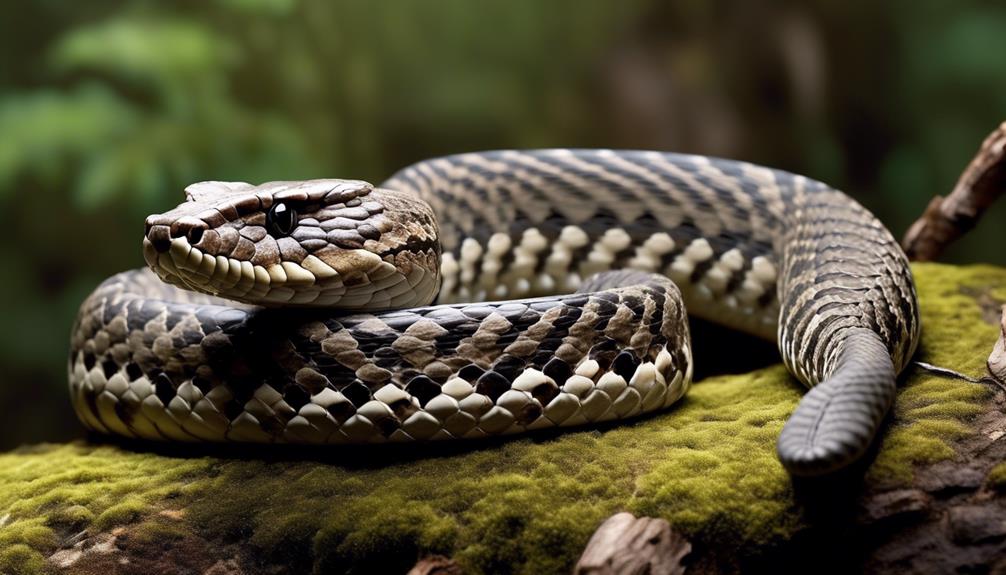
Now let’s turn our attention to the Massasauga (Sistrurus catenatus), a venomous snake species found in a small corner of southern Ontario.
Typically measuring no more than 70cm in length, Massasaugas have dark coloring heavily patterned with diamond-like camouflage.
They’re highly venomous, and their bites can be fatal if left untreated.
Habitat and Range
The Massasauga, a highly venomous snake species, inhabits a small corner of southern Ontario in Canada. This snake is usually no more than 70cm in length and has a dark coloring heavily patterned with diamond-like camouflage. The Massasauga is a versatile survivalist, capable of living in various habitats. It can be found in wetlands, marshes, and open grasslands.
This snake prefers areas with dense vegetation and moist soil, as it provides cover and ample hunting opportunities. The Massasauga is also known to hibernate in underground burrows during the winter months. Its limited range and specific habitat requirements make it vulnerable to habitat loss and fragmentation. Efforts to protect and conserve its habitat are crucial for the survival of this species.
| Habitat | Range | Behavior |
|---|---|---|
| Wetlands | Southern Ontario | Hibernates in burrows |
| Marshes | Canada | Prefers dense vegetation |
| Grasslands | Limited range | Versatile survivalist |
| Moist soil | Vulnerable to habitat loss |
Venom and Bite Effects
After exploring the habitat and range of the Massasauga snake in southern Ontario, it’s important to understand the venom and bite effects of this highly venomous species, known as Sistrurus Catenatus.
The venom of the Massasauga snake is a potent mix of neurotoxins and enzymes that can cause severe damage to its prey and potential threats. When a bite occurs, the venom is injected into the victim’s bloodstream through hollow fangs.
The venom acts by disrupting the nervous system, leading to symptoms such as intense pain, swelling, and bruising at the bite site. Systemic effects may include nausea, vomiting, dizziness, and difficulty breathing. If left untreated, the bite can be fatal, particularly in children or individuals with compromised health.
Immediate medical attention and administration of antivenom are crucial in managing the effects of a Massasauga snake bite.
Non-Venomous Snakes in Canada
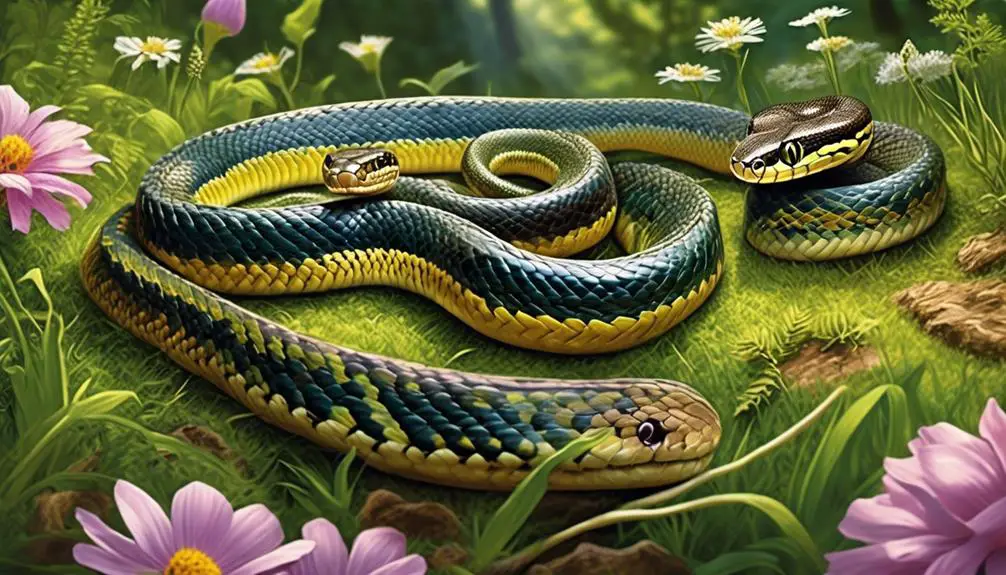
Non-venomous snakes, found throughout various provinces in Canada, pose no threat to humans and play an important role in the ecosystem. One such non-venomous snake is the Common Water Snake (Nerodia sipedon). These snakes can be found in prairies, Great Plains, and wooded lowlands of the Canadian coast ranges. They prefer aquatic habitats such as lakes, rivers, and wetlands. Growing up to 120cm in length, they feed on fish, frogs, and small mammals.
The habitat and behavior of the Common Water Snake are closely tied to water. They reside in water and can often be seen basking in the warmth on lakeside rocks and boulders. During the daylight hours, they hide in creek-side rocks and bushes. Their diet primarily consists of surface insects and smaller water fish.
As non-venomous snakes, Common Water Snakes lack venom. However, when startled, they release a foul-smelling musk as a defense mechanism. While they can cause skin damage through biting, their main goal is to warn off potential threats by emitting their pungent musk. Removing the odor can be challenging.
Canada is home to a total of 24 snake species, with three species being seriously venomous. The Gray Rat Snake, the largest snake in Canada, falls into the non-venomous category. These snakes can grow up to six feet in length and are native to wooded areas around Lake Erie and Lake Ontario. While they’re non-venomous, they can cause local tissue damage if startled. Gray Rat Snakes use their tail rattle to warn and intimidate potential threats.
One of the rarest snakes in Canada is the Blue Racer Snake. Limited to one half of Pelee Island in Lake Erie, this unique species hasn’t been seen since the early 1980s. Due to its rarity and restricted range, conservation efforts are crucial for the survival of the Blue Racer Snake.
Desert Nightsnake (Hypsiglena torquate)
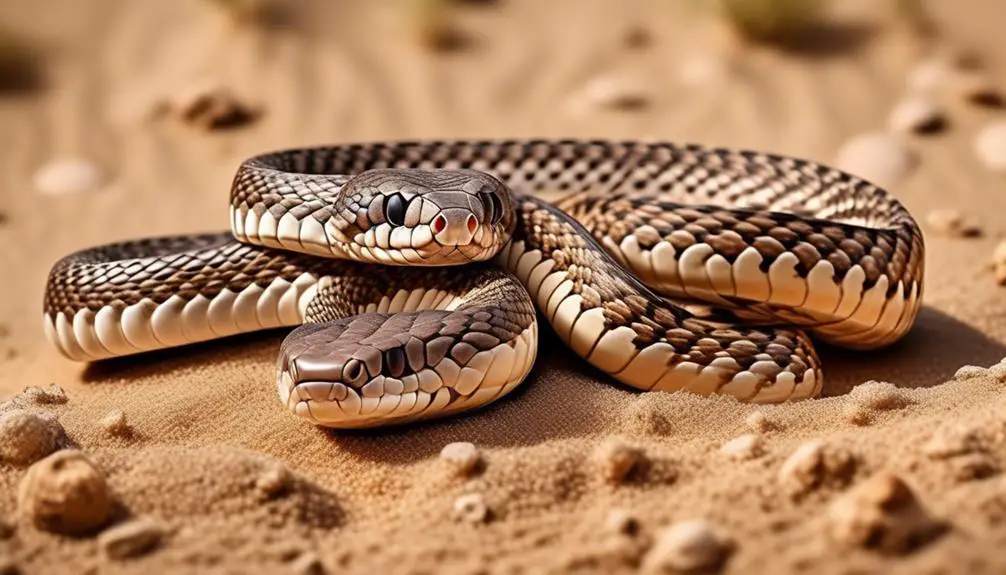
Now let’s turn our attention to the Desert Nightsnake (Hypsiglena torquate), a unique snake species found only in the compact Okanagan Country on the US-Canada border of British Columbia.
These snakes are rare and hardly venomous, making them relatively harmless to humans. They’re nocturnal creatures, mostly active at night.
The Desert Nightsnake is a smallish snake, measuring around 30-50cm in length. Their appearance is dull, with a thin and monochrome brownish color. They’ve smooth scales and a slender body, allowing them to move easily through the rocky terrain of their habitat.
These snakes are adept climbers and can be found hiding under rocks or in crevices during the day. They primarily feed on small lizards, insects, and occasionally small mammals.
While they may not be as well-known as other snake species in Canada, the Desert Nightsnake plays an important role in maintaining the balance of its ecosystem. Conservation efforts should be made to protect their habitat and ensure their continued survival.
Gray Rat Snake (Pantherophis spiloides)
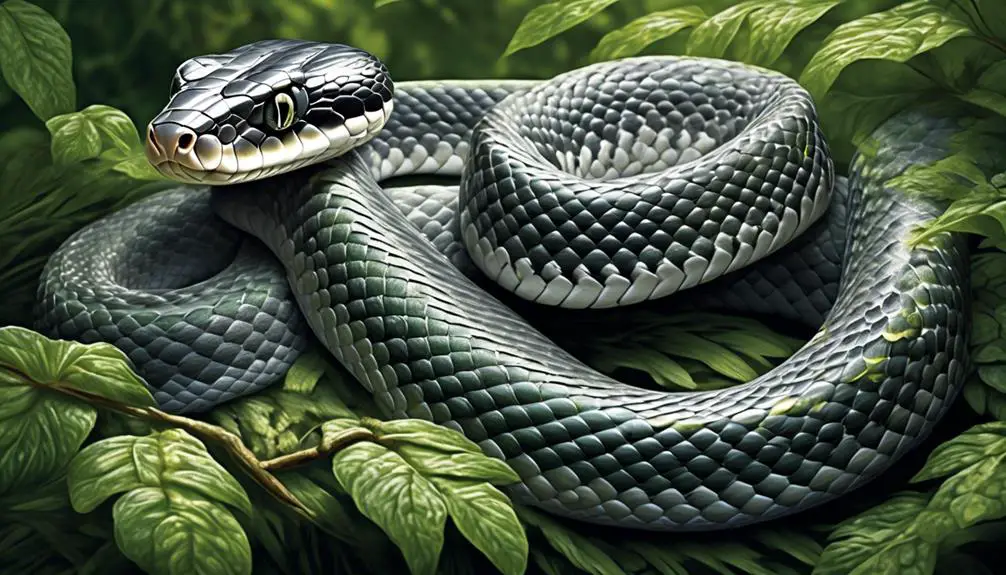
The Gray Rat Snake (Pantherophis spiloides) is the largest snake species in Canada, capable of reaching lengths of up to six feet. Native to wooded areas around Lake Erie and Lake Ontario, this non-venomous snake has heavily patterned bodies, appearing black in young snakes. While it may not possess venom, it can cause local tissue damage if startled. To warn and intimidate potential threats, the Gray Rat Snake uses its tail rattle.
To provide a deeper understanding of this species, here is a table summarizing key details about the Gray Rat Snake:
| Gray Rat Snake (Pantherophis spiloides) | |
|---|---|
| Length | Up to six feet |
| Native Habitat | Wooded areas |
| Distribution | Around Lake Erie and Lake Ontario |
| Venomous | No |
| Tail Rattle | Yes |
As the largest snake in Canada, the Gray Rat Snake plays an important role in its ecosystem. It helps control rodent populations, contributing to the balance of the food chain. Although it may startle some with its size and appearance, it is a valuable member of the Canadian snake community.
Blue Racer Snake (Coluber constrictor foxii)
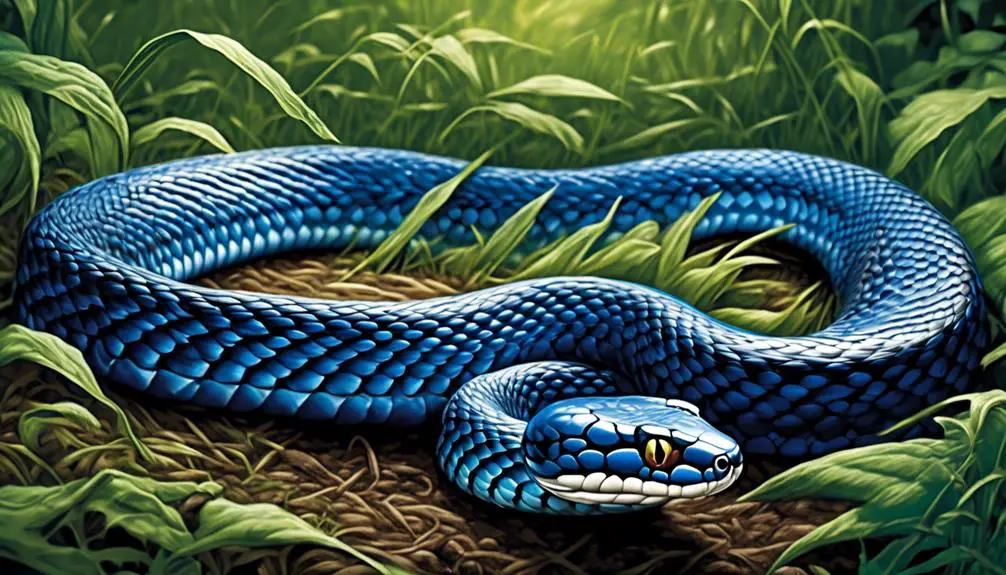
Now, let’s turn our attention to the Blue Racer Snake (Coluber constrictor foxii). This unique species is found exclusively on Pelee Island of Lake Erie in Canada, with its population limited to just one half of the island.
Unfortunately, sightings of the Blue Racer Snake have become increasingly rare since the early 1980s, making its conservation status a matter of concern. In order to ensure the survival of this highly unique snake, efforts to protect its limited habitat and population are of utmost importance.
Distribution and Range
The distribution and range of the blue racer snake, Coluber constrictor foxii, is limited to one half of Pelee Island in Lake Erie, making it the rarest snake species in Canada.
This unique snake species can only be found on this specific island and was last seen in the early 1980s. The restricted territory and population of the blue racer snake have raised conservation concerns.
Efforts to protect and preserve this species are crucial due to its rarity and limited range. The blue racer snake’s habitat is threatened, and its survival depends on conservation measures.
It’s essential to understand the distribution and range of this snake species to effectively implement conservation strategies and ensure its long-term survival.
Habitat and Behavior
Habitat and Behavior of the Blue Racer Snake (Coluber constrictor foxii) can be understood by examining its preferred environments and unique characteristics.
This highly unique snake species is found only on Pelee Island of Lake Erie, Canada. It’s limited to one half of the island and was last seen in the early 1980s, making it a specific conservation concern due to its rarity and restricted range.
The Blue Racer Snake prefers open habitats such as grasslands, meadows, and agricultural fields. It’s a diurnal species, meaning it’s active during the day. This snake is known for its incredible speed and agility, often seen darting across the ground or climbing low shrubs and trees.
Its behavior includes hunting small mammals and birds, as well as basking in the sun to regulate its body temperature. The Blue Racer Snake is an important species to conserve due to its limited territory and population.
Conservation Status
After exploring the habitat and behavior of the Blue Racer Snake (Coluber constrictor foxii) on Pelee Island of Lake Erie, Canada, it’s crucial to address its current conservation status.
The Blue Racer Snake is considered the rarest snake species in Canada, with a limited population and habitat. It’s confined to only one half of Pelee Island and was last seen in the early 1980s. Due to its unique characteristics and restricted range, the Blue Racer Snake faces specific conservation concerns.
The protection and preservation of its habitat are of utmost importance to ensure the survival of this highly unique snake species. Efforts to monitor and conserve the population of the Blue Racer Snake are essential to prevent its further decline and potential extinction.
Common Water Snake (Nerodia sipedon)
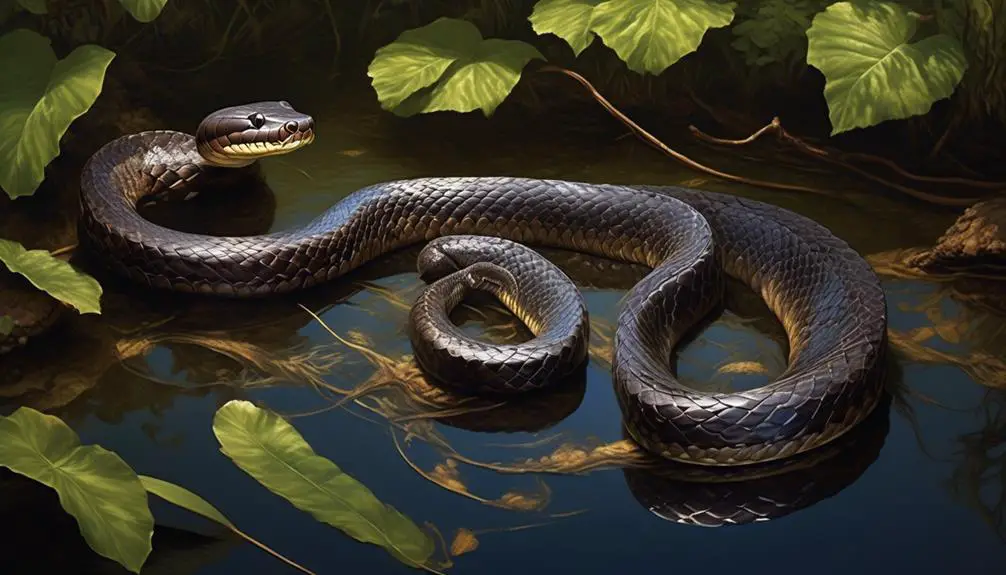
Common Water Snake, also known as Nerodia sipedon, is a non-venomous snake species found throughout various provinces in Canada. These snakes are harmless to humans and prefer aquatic habitats such as lakes, rivers, and wetlands. They can grow up to 120cm in length and have a diet that consists of fish, frogs, and small mammals.
Common Water Snakes can be found in prairies, Great Plains, and wooded lowlands of the Canadian coast ranges. They primarily reside in water and can often be seen basking in the warmth on lakeside rocks and boulders. During their active hours, they hunt for surface insects and smaller water fish. However, during the daylight, they hide in creek-side rocks and bushes for protection.
In terms of defense mechanisms, Common Water Snakes don’t have venom. Instead, when startled, they release a foul-smelling musk as a deterrent. While they aren’t aggressive towards humans, they can cause skin damage through biting if they feel threatened. Their foul-smelling musk can also be difficult to remove.
Canada is home to a total of 24 known snake species, with the Common Water Snake being one of the non-venomous ones. It’s important to note that there are three seriously venomous snake species in Canada, with the rattlesnakes being the most dangerous to humans if bites are left untreated. The Gray Rat Snake, on the other hand, is the largest snake in Canada.
Habitat and Behavior of Common Water Snakes
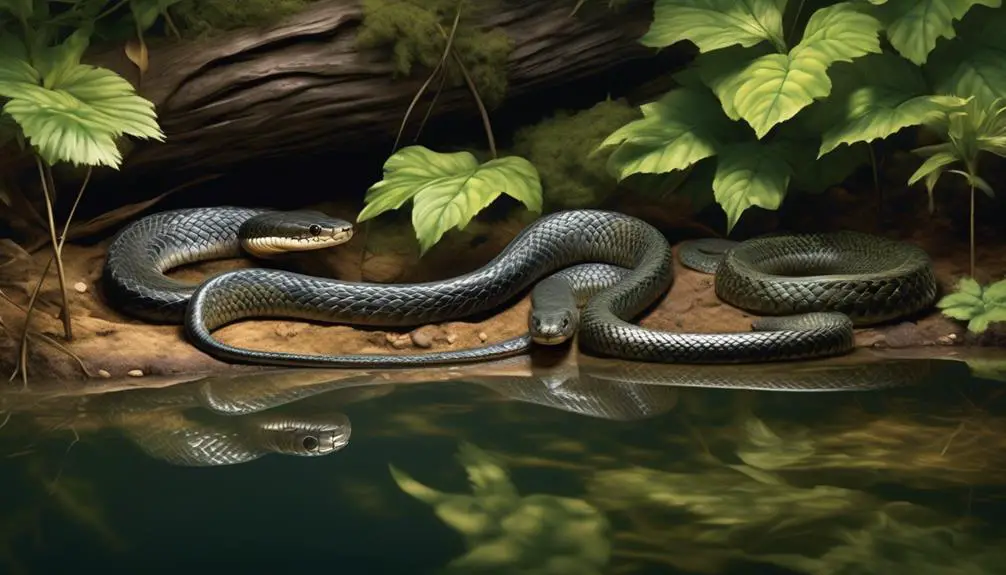
Basking in the warmth of lakeside rocks and boulders, Common Water Snakes actively hunt for surface insects and smaller water fish during their active hours. These non-venomous snakes are found throughout various provinces in Canada, preferring aquatic habitats such as lakes, rivers, and wetlands. Growing up to 120cm in length, they’re harmless to humans but can cause skin damage through biting.
Common Water Snakes can be found in prairies, Great Plains, and wooded lowlands of the Canadian coast ranges. They primarily reside in water, seeking refuge in creek-side rocks and bushes during daylight. Their diet consists of fish, frogs, and small mammals, which they capture with their quick strikes and powerful jaws.
When threatened, Common Water Snakes don’t have venom to defend themselves. Instead, they release a foul-smelling musk to deter predators and warn potential threats. Getting too close can result in skin damage from their bites, and the foul-smelling musk can be difficult to remove.
In Canada, Common Water Snakes are just one of the 24 known snake species. With their unique habitat and behavior, they contribute to the diverse snake population in the country. Understanding their ecology and conservation needs is crucial for their coexistence with humans and the preservation of their natural habitats.
Common Water Snake’s Defense Mechanisms
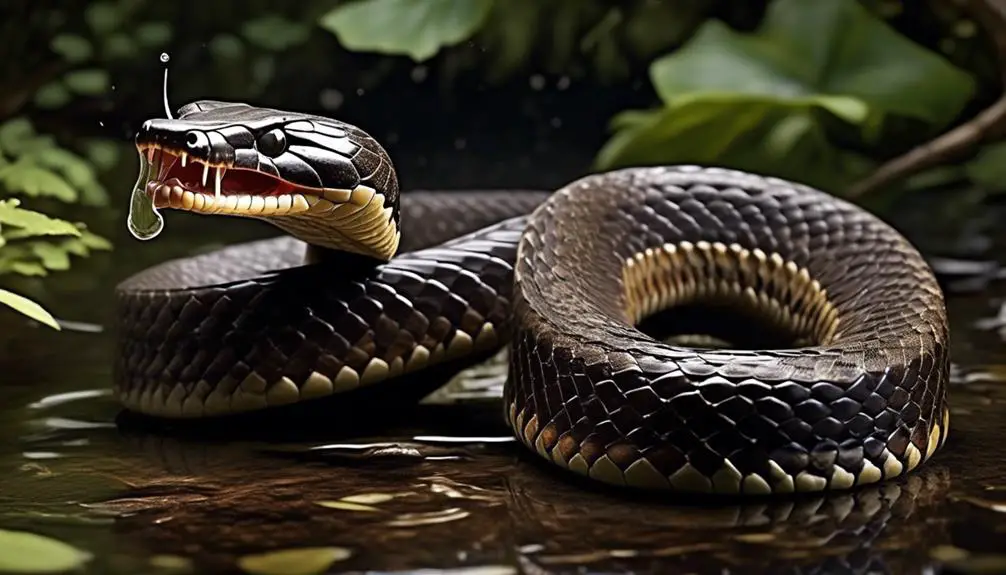
When faced with threats, the Common Water Snake employs a unique set of defense mechanisms to protect itself and ward off potential predators. Unlike venomous snakes, the Common Water Snake doesn’t possess venom as a means of defense. Instead, it relies on a combination of tactics to deter predators.
One of its primary defense mechanisms is the release of a foul-smelling musk when startled or threatened. This musk acts as a deterrent, warning predators to stay away.
Additionally, the Common Water Snake is capable of causing skin damage through biting, which can further discourage predators from attacking.
When feeling threatened, the snake also adopts a defensive posture, coiling its body and opening its mouth wide to display its sharp teeth. This intimidating display can often be enough to ward off potential threats.
It’s worth noting that the foul-smelling musk released by the Common Water Snake can be difficult to remove, making it an effective defense mechanism.
Number of Snake Species in Canada
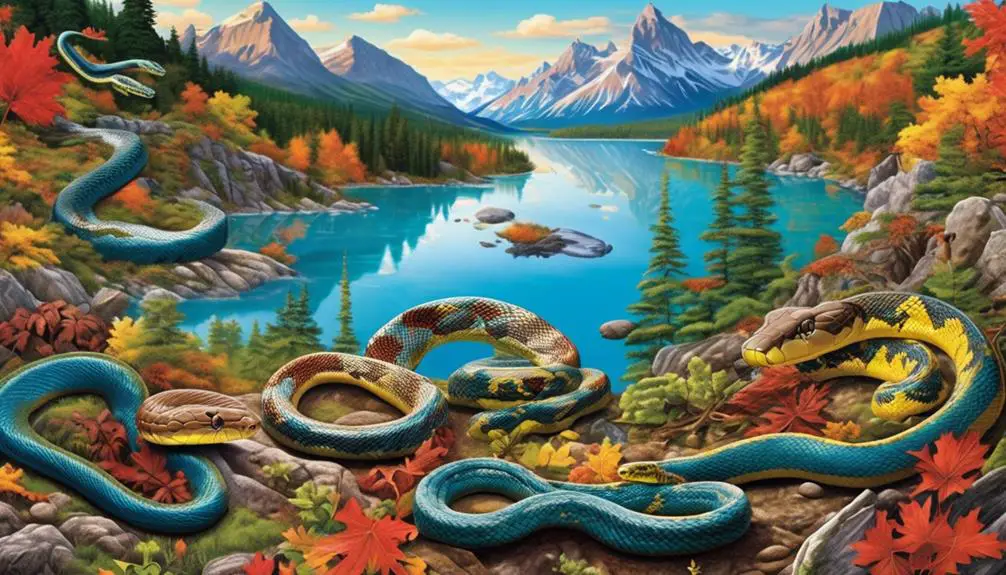
Canada is home to a diverse range of snake species, with a total of 24 known snake species inhabiting the country. Among these, three species are seriously venomous, while one species is technically venomous but only capable of killing small prey.
The rattlesnakes, including the Western rattlesnake and the Prairie rattlesnake, are the most dangerous to humans if bites are left untreated. The Gray rat snake, measuring up to six feet in length, is the largest snake in Canada. On the other hand, the Blue racer snake is considered the rarest snake in the country, with a limited population and a threatened habitat. Conservation efforts are crucial for the survival of this unique species.
It’s important to note that the Common Water Snake, found throughout various provinces in Canada, is non-venomous and harmless to humans. This species prefers aquatic habitats such as lakes, rivers, and wetlands, and can grow up to 120cm in length.
Rare Snakes in Canada
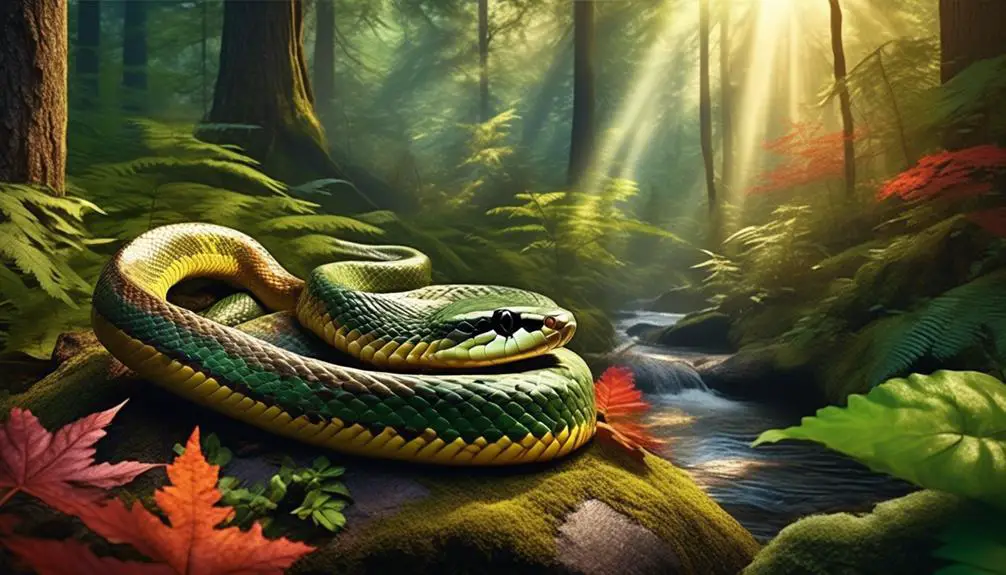
The Blue racer snake, being the rarest snake species in Canada, faces unique conservation challenges due to its limited population and threatened habitat. This unique species is found only on Pelee Island of Lake Erie, Canada, and is limited to one half of the island. The Blue racer snake was last seen in the early 1980s, making it extremely rare and raising concerns about its survival.
Conservation efforts for the Blue racer snake are crucial due to its rarity and restricted range. To better understand the significance of this snake, let’s take a look at a comparison table:
| Snake Species | Population | Habitat Threatened? |
|---|---|---|
| Blue racer snake | Limited | Yes |
| Western rattlesnake | Select parts of British Columbian mountains | Yes |
| Prairie rattlesnake | Alberta and Saskatchewan | Yes |
| Massasauga | Small corner of southern Ontario | No |
As you can see, the Blue racer snake stands out as the rarest snake species in Canada with its limited population and threatened habitat. Conservation efforts are vital to protect this unique snake from extinction. By raising awareness, implementing protective measures, and preserving its habitat, we can ensure the survival of the Blue racer snake for future generations.

Erzsebet Frey (Eli Frey) is an ecologist and online entrepreneur with a Master of Science in Ecology from the University of Belgrade. Originally from Serbia, she has lived in Sri Lanka since 2017. Eli has worked internationally in countries like Oman, Brazil, Germany, and Sri Lanka. In 2018, she expanded into SEO and blogging, completing courses from UC Davis and Edinburgh. Eli has founded multiple websites focused on biology, ecology, environmental science, sustainable and simple living, and outdoor activities. She enjoys creating nature and simple living videos on YouTube and participates in speleology, diving, and hiking.

